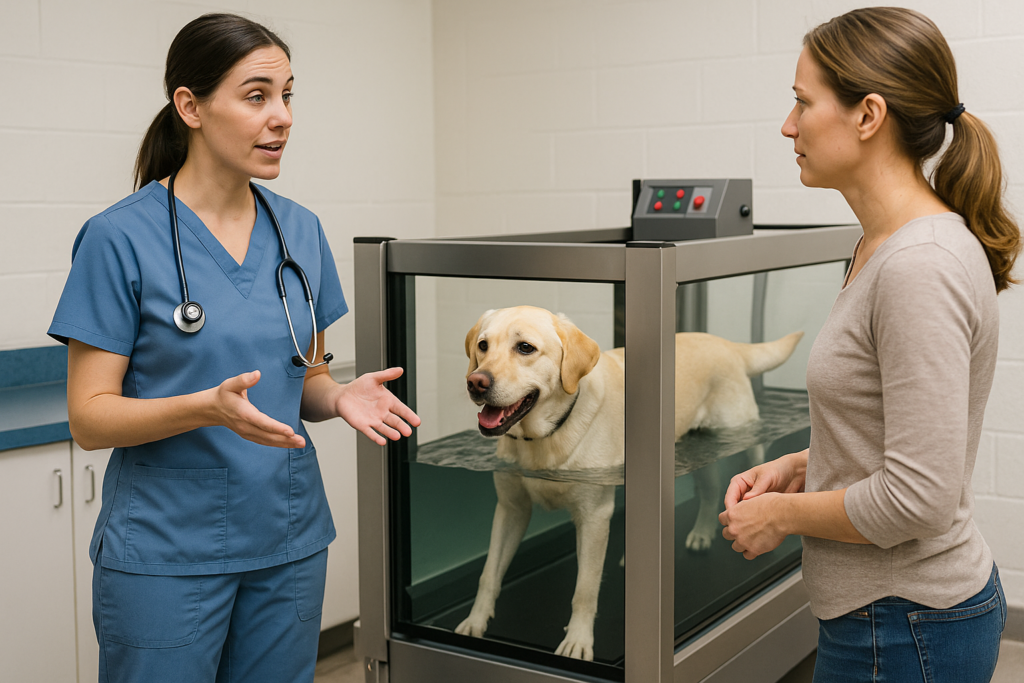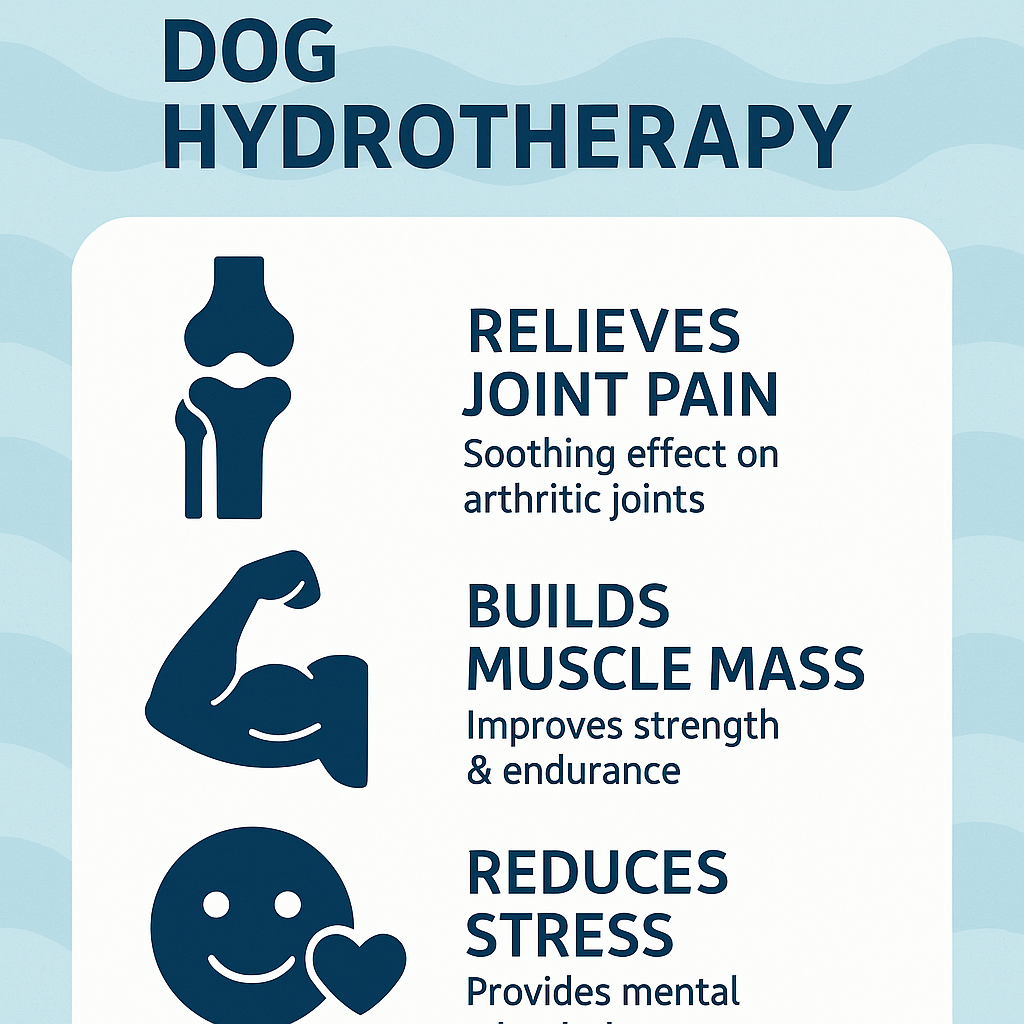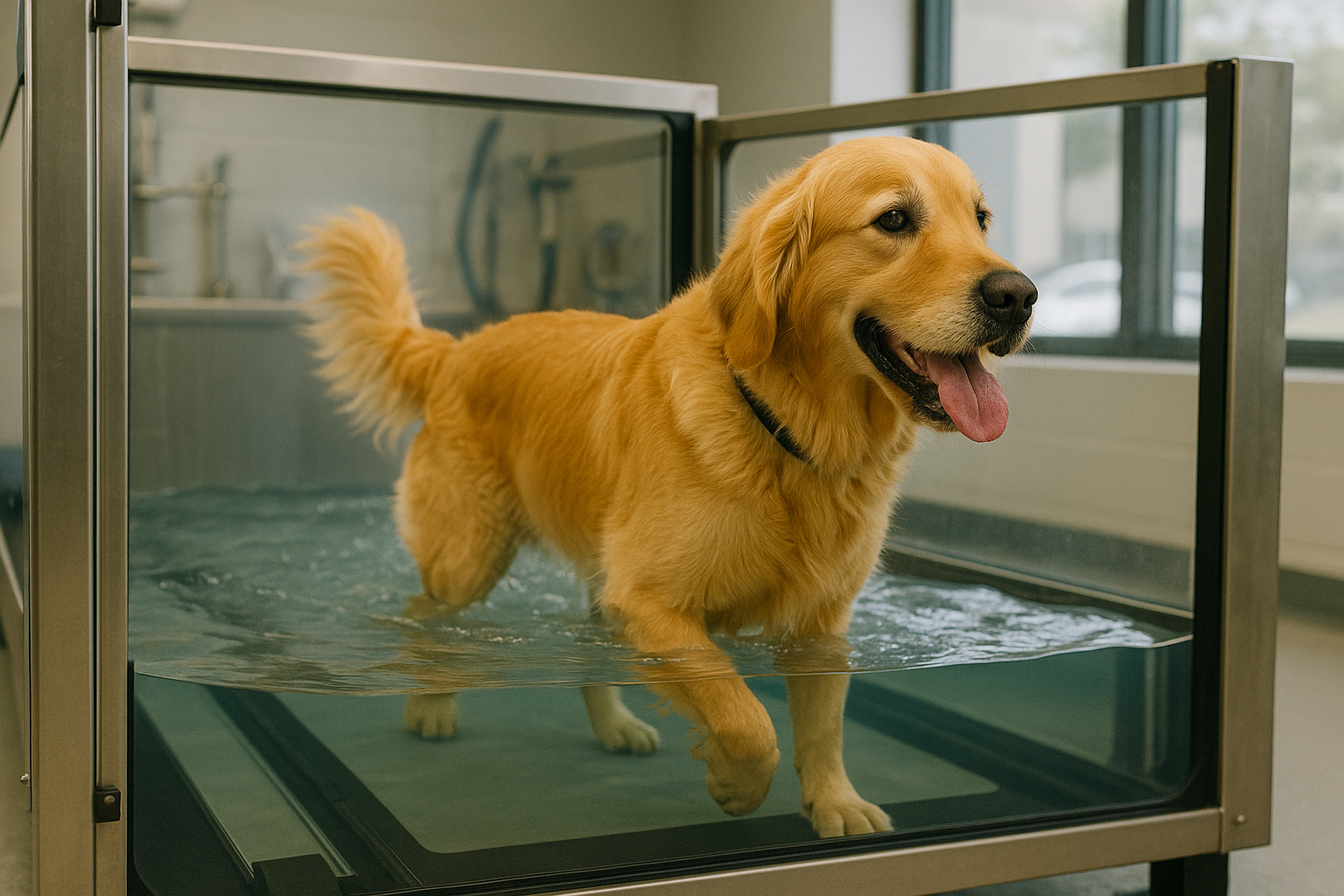Medical disclaimer: This article is for informational purposes only and does not replace professional veterinary advice. Always consult your veterinarian before starting any therapy.
Table of Contents
Watching your dog struggle to walk or bounce back after surgery can be heartbreaking. As a veterinarian in Ottawa, I’ve seen hydrotherapy for dogs transform recovery journeys from easing the limp of a senior Lab with arthritis to helping a post-op Shepherd rebuild strength without pain. It’s not just water therapy; it’s a lifeline for healing.
Hydrotherapy for dogs uses the natural properties of water buoyancy, resistance, and warmth to aid in physical rehabilitation and fitness. Whether your pup is dealing with hip dysplasia, recovering from surgery, or just needs gentle exercise, this treatment offers a safe, low-impact solution. In this guide, we’ll explore how dog hydrotherapy works, the best conditions it treats, the typical canine recovery timeline, and what to expect from a professional program.
Key Takeaways
- Hydrotherapy for dogs is a water-based rehabilitation technique used to improve mobility, reduce pain, and strengthen muscles after surgery, injury, or in chronic conditions like arthritis.
- It’s especially useful when land-based exercise is too painful or risky.
- Dogs typically begin seeing improvements within a few sessions, depending on their condition and the canine recovery timeline.
- Professional hydrotherapy (with underwater treadmills or swim tanks) is safer and more effective than unsupervised recreational swimming.
- Typical Canadian hydrotherapy sessions range from $20–$50, and some pet insurance plans offer partial reimbursement.
- Always consult your veterinarian before starting hydrotherapy, especially for dogs with medical conditions or recent surgery.
What Is Hydrotherapy for Dogs?
Also see: https://doglifeexpert.com/top-10-basic-dog-acupuncture-points/

Hydrotherapy for dogs is a specialized form of physical therapy that uses water to help dogs heal, recover, or stay fit. The water’s natural properties such as buoyancy, resistance, and hydrostatic pressure make it an ideal environment for gentle but effective exercise.
There are three main types of dog hydrotherapy:
- Underwater Treadmill Therapy: Dogs walk on a treadmill submerged in water, allowing precise control over speed and water depth to reduce joint strain.
- Swimming Therapy: In controlled pools, dogs swim freely or with guidance to improve stamina, range of motion, and muscle tone.
- Whirlpool Therapy: Gentle jets massage muscles, improve circulation, and offer pain relief, often used for relaxation or post-operative care.
These therapies are used under veterinary supervision or by certified canine rehabilitation therapists. They can help maintain conditioning, speed recovery, and manage conditions in a low-impact way. The use of hydrotherapy for dogs continues to grow across Canada, especially in urban areas with dedicated rehab centers.
By reducing gravitational stress on joints and encouraging full-body movement, hydrotherapy becomes a powerful tool in both recovery and prevention.
When Is Hydrotherapy Used in Dogs?

Hydrotherapy for dogs is not just a post-surgical tool it’s used across a wide range of medical and wellness scenarios. Below are common reasons a veterinarian may recommend it:
Post-Surgical Rehabilitation
After orthopedic surgeries such as TPLO (for cruciate ligament rupture) or hip replacement, hydrotherapy helps rebuild strength and maintain mobility. The buoyancy of water protects healing joints from strain.
Arthritis and Hip Dysplasia
For senior dogs with degenerative joint disease or hip dysplasia, hydrotherapy benefits for dogs include pain relief, improved joint flexibility, and preservation of muscle tone without stressing the joints.
Obesity and Weight Management
Overweight dogs benefit from swimming or treadmill work without worsening joint issues. Controlled aquatic exercise supports calorie burning and cardiovascular health safely.
Injury Recovery
Whether it’s a soft tissue injury or fracture, dog hydrotherapy encourages gentle movement during healing phases, preventing muscle atrophy and joint stiffness.
Neurological Conditions
Dogs recovering from intervertebral disc disease (IVDD) or spinal surgery often use hydrotherapy to retrain motor function and restore coordination, especially during the critical early weeks of the canine recovery timeline.
Fitness and Conditioning
Even healthy dogs like agility athletes or senior dogs needing low-impact activity can gain from hydrotherapy. It keeps muscles active and joints mobile without risk of overuse injuries.
Benefits of Hydrotherapy for Dogs

The advantages of hydrotherapy for dogs go far beyond just physical recovery. From easing pain to boosting mood, it supports both body and mind during healing.
Physical Benefits
- Low-Impact Exercise: Water reduces the effects of gravity, allowing dogs to move with less strain on joints essential during recovery or in senior dogs.
- Muscle Strengthening: Water resistance builds muscle tone, which is vital post-surgery or during long-term conditions like hip dysplasia.
- Improved Joint Flexibility: Regular hydrotherapy maintains or improves range of motion, especially in arthritic dogs.
- Pain and Inflammation Relief: Warm water increases blood flow and relaxes muscles, helping reduce pain and swelling.
- Better Circulation: Enhanced blood flow speeds healing and improves oxygen delivery to tissues.
- Cardiovascular Conditioning: Swim sessions boost stamina and heart health, aiding overweight or deconditioned dogs.
Psychological Benefits
- Reduced Anxiety: The soothing nature of warm water and a calming environment can help anxious or injured dogs relax.
- Mental Stimulation: For dogs on restricted land activity, water therapy provides much-needed movement and stimulation.
- Confidence Rebuilding: Dogs regaining use of a limb or recovering from surgery often rebuild trust in their bodies through safe, supported movement.
https://www.akc.org/expert-advice/health/hydrotherapy-for-dogs/
Summary Table: Hydrotherapy Benefits by Recovery Phase
| Recovery Stage | Hydrotherapy Benefits for Dogs |
|---|---|
| Immediate Post-Op | Non-weight bearing movement, improved circulation, reduced swelling |
| 2–4 Weeks Post-Op | Muscle strengthening, increased range of motion |
| Chronic Arthritis Care | Ongoing pain relief, preserved mobility, reduced stiffness |
| Injury Rehabilitation | Promotes healing, prevents muscle atrophy |
| Weight Management | Burns calories safely, reduces joint load |
| Neurological Recovery | Re-establishes gait patterns, improves coordination |
Hydrotherapy for dogs has quickly become a cornerstone in modern veterinary rehabilitation plans.
Typical Canadian Hydrotherapy Costs
One common question from pet owners is: How much does hydrotherapy for dogs cost in Canada? Prices vary depending on location, session type, and whether your dog needs a custom rehabilitation plan.
Average Cost Breakdown
| Service Type | Estimated Cost (CAD) |
|---|---|
| Initial Rehabilitation Assessment | $80 – $150 |
| Swim Session (30 minutes) | $25 – $40 |
| Underwater Treadmill Session | $35 – $60 |
| Package (6–10 sessions) | $200 – $450 (discounted rates available) |
- In cities like Toronto or Vancouver, prices may run higher due to demand.
- Some clinics require a referral from your veterinarian.
- Costs may increase if combined with manual therapy or laser treatments.
Insurance Coverage in Canada
Some pet insurance providers like Trupanion or Pets Plus Us may reimburse hydrotherapy for dogs when it’s prescribed by a veterinarian as part of a recovery plan. Always check your policy details or ask your vet’s office to assist with pre-approval paperwork.
Home Checklist: Is Hydrotherapy Right for Your Dog?
Before booking a session or diving into your backyard pool, assess whether dog hydrotherapy is appropriate and safe for your pup.
✅ 5-Minute Home Checklist

Take this quick at-home evaluation before speaking to your vet:
- Has your dog recently had surgery or an injury requiring restricted movement?
- Is your dog limping or stiff after rest or walks?
- Does your dog struggle with stairs or slippery floors?
- Is your dog overweight, making exercise difficult?
- Has your vet mentioned arthritis, hip dysplasia, or IVDD?
- Is your dog anxious or depressed during crate rest or inactivity?
- Are you noticing muscle loss in one or more limbs?
If you answered “yes” to two or more, hydrotherapy for dogs may be beneficial. However, always consult your veterinarian to tailor a program to your pet’s condition and to avoid any complications.
When to Avoid DIY Hydrotherapy
Avoid unsupervised water exercise if your dog:
- Has open surgical wounds or stitches
- Has heart conditions or seizures
- Is afraid of water or panics in unfamiliar environments
- Is prone to ear infections
- Is in the early post-op phase (typically under 14 days)
Your vet may recommend waiting or modifying water therapy until your dog is medically stable.
Professional vs. Recreational Hydrotherapy
Hydrotherapy for dogs can take place in both clinical settings and casual environments but their goals and safety levels differ.
Professional Hydrotherapy
Conducted by certified canine rehabilitation therapists (CCRTs) or veterinary physiotherapists, these sessions are tailored for medical recovery.
Benefits:
- Individualized care plans
- Safe, controlled environments (filtered, heated pools or underwater treadmills)
- Progress tracking with reports to your vet
- Therapists adjust water level, resistance, and session length
- Often combined with laser, acupuncture, or manual therapy
Best for: post-op patients, arthritis, injuries, obesity, IVDD recovery
Recreational Hydrotherapy
This refers to non-medical swimming, such as in a home pool or lake.
Benefits:
- Great for fit, healthy dogs who enjoy swimming
- Can supplement regular exercise
- Enhances mental stimulation
Risks Without Guidance:
- Unsafe water quality (e.g., bacteria in lakes or harsh pool chemicals)
- Overexertion or fatigue in overweight or senior dogs
- Poor swimming skills in certain breeds (e.g., Bulldogs, Dachshunds)
- No therapeutic targeting of muscle groups or range of motion
Tip: If you’re using recreational water, make sure to monitor closely and avoid slippery surfaces or unmonitored deep areas.
Potential Risks & Contraindications
While hydrotherapy for dogs is generally safe, especially under professional supervision, there are some risks and limitations to be aware of.
Possible Risks
- Ear Infections: Water entering the ears may lead to infections, especially in floppy-eared breeds. Dry ears thoroughly after each session.
- Skin Irritation: Chlorinated or untreated water can aggravate skin conditions. Dogs with hot spots or dermatitis should wait until cleared by a vet.
- Fatigue or Drowning Risk: Overexertion can occur in overweight or elderly dogs. Constant supervision is necessary.
- Water Intoxication: Rare, but can occur if a dog swallows too much water during play.
- Stress or Fear: For dogs unaccustomed to water, forcing sessions may worsen anxiety. Start gradually with positive reinforcement.
Contraindications
- Recent Surgery with Open Incisions: Wait until sutures are removed and wounds are fully healed.
- Uncontrolled Heart Disease or Seizures: Water exercise may pose risks due to sudden exertion or stimulation.
- Severe Respiratory Issues: Water pressure can restrict breathing in some dogs.
- Severe Neurological Instability: Dogs who cannot support themselves may need harnesses or other supports.
Your veterinarian will help determine the timing and suitability of starting dog hydrotherapy based on a thorough exam.
Prevention & Maintenance Tips
Hydrotherapy for dogs isn’t just for recovery it can also help prevent future injuries and keep your pup fit, especially in senior years.
How to Prevent Injury Using Hydrotherapy
- Warm-Up Phase: Begin each session with slow, controlled movements to prepare joints and muscles.
- Consistent Sessions: Regular hydrotherapy maintains muscle tone and flexibility, reducing injury risk.
- Monitor Weight: Weight-bearing joints benefit from reduced stress as your dog sheds pounds in the water.
- Post-Activity Stretching: Gentle stretching after water sessions improves recovery and prevents tightness.
- Avoid Overexertion: Especially important in recreational settings limit swims to 5–10 minutes at first and watch for fatigue.
Long-Term Mobility Maintenance
Maintaining your dog’s mobility isn’t just about recovery it’s about preserving their comfort and quality of life for the long haul. For aging pets or those with chronic conditions, hydrotherapy for dogs plays a key role in long-term wellness.
Monthly Hydrotherapy Check-Ins
For dogs with arthritis, hip dysplasia, or other degenerative joint issues, consistent hydrotherapy sessions often once every 3 to 4 weeks can prevent stiffness, reduce inflammation, and slow disease progression. These check-ins help identify subtle changes in gait or strength early, allowing for prompt treatment adjustments. Regular aquatic exercise also helps maintain joint lubrication and muscle tone, which are often lost in inactive or senior pets.
Combine with Complementary Therapies
To enhance results, many veterinarians recommend integrating hydrotherapy for dogs with other evidence-based modalities. These may include:
- Laser therapy: Reduces inflammation and stimulates tissue healing
- Massage and manual therapy: Improves circulation and range of motion
- Acupuncture: Supports nervous system function and pain control
By addressing multiple aspects of a dog’s health, these therapies create a synergistic effect that can significantly boost mobility and comfort.
At-Home Exercises to Support Progress
Between hydrotherapy sessions, your rehab therapist may prescribe simple home exercises to reinforce gains made in the water. These might include:
- Towel walking (supporting the hind end with a towel sling) to encourage proper gait
- Weight shifting exercises to build core strength and balance
- Balance boards or wobble cushions to stimulate joint stability and muscle coordination
These activities should be performed under professional guidance, with frequency and difficulty adjusted over time. The goal is to create a sustainable, low-stress mobility routine that adapts to your dog’s changing needs.
By sticking to a consistent hydrotherapy and maintenance schedule, pet parents can help their dogs remain active, comfortable, and confident even in their golden years.
FAQs About Hydrotherapy for Dogs
Here are some common questions pet parents ask about dog hydrotherapy and what to expect during the canine recovery timeline.
1. How many hydrotherapy sessions does my dog need?
It depends on the condition. Post-operative cases may need 2–3 sessions per week for 4–8 weeks. Chronic arthritis may benefit from ongoing weekly therapy. Your vet or canine rehab therapist will guide frequency.
2. Can my dog just swim in the lake instead?
Not recommended for rehabilitation. Lakes may contain bacteria or have currents that could stress healing joints. Controlled settings ensure safety, water quality, and targeted therapy.
3. Will pet insurance cover hydrotherapy?
Some Canadian providers do, but only when prescribed by a vet and performed by a certified therapist. Always check your plan first.
4. What if my dog is scared of water?
Introduce hydrotherapy slowly. Therapists are trained to help fearful dogs build confidence using positive reinforcement and shallow water levels.
5. How soon after surgery can my dog start hydrotherapy?
Usually after 10–14 days, once incisions have healed and your vet gives the green light. Starting too soon can risk infection or tissue damage.
6. Are all breeds suited for hydrotherapy?
Yes, but some (like Bulldogs or Dachshunds) may need flotation vests or more support. Every program is customized for breed, size, and medical history.
Conclusion: My Take as a Canadian Vet
Over the years, I’ve watched hydrotherapy for dogs help countless patients regain mobility, strength, and joy. One case that sticks with me is Luna, a 9-year-old Golden Retriever with arthritis so bad she could barely climb stairs. After six weeks of supervised hydrotherapy, she was walking 30 minutes daily, tail wagging again. That transformation safe, steady, and stress-free is what makes this therapy so remarkable.
Whether your dog is bouncing back from surgery or simply aging gracefully, hydrotherapy for dogs offers a kind, effective path to recovery. It’s not a one-size-fits-all solution, but with proper veterinary guidance, it can be life-changing.
Remember, early intervention is key. Speak with your vet to see if dog hydrotherapy fits your pup’s needs, and don’t wait until mobility is gone to act. With consistency, compassion, and the right care, dogs of all ages and abilities can thrive in the water.





Pingback: Can Dogs Eat Oranges? Top 10 Surprising Truths About Citrus and Dogs